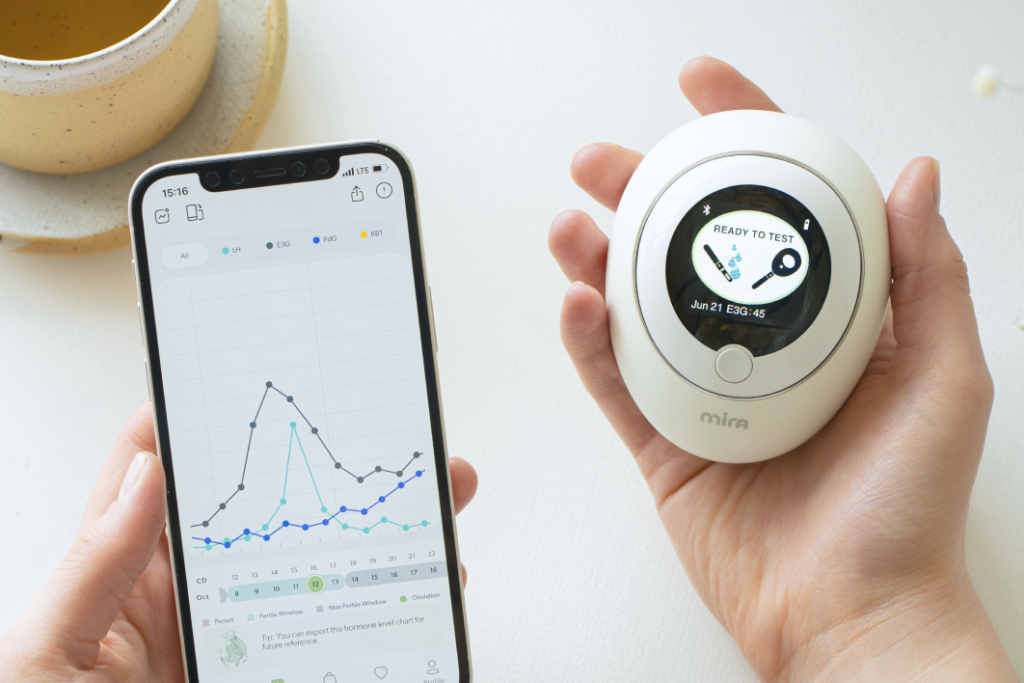How to Get Pregnant in Your 30s

It’s no secret that fertility naturally declines with age – but that doesn’t mean getting pregnant in your mid to late 30s is impossible or even out of the ordinary. What it does mean though is that your lifestyle choices have an even bigger impact on your ability to conceive than they did in your 20s.
Ready to get serious about getting pregnant fast in your 30s? Here are 4 science-backed tips that can help.
4 tips to boost fertility in your 30s
1. Maintain a balanced diet

The foods and drinks we consume have a profound impact on our hormone patterns, which in turn can interrupt ovulation and decrease our chances of conception. Not only that, but being over or underweight can also have a negative impact on our fertility.
If you are trying to conceive (TTC) in your 30s, make sure that you are consuming enough fiber, iron, calcium omega-3 fatty acids, and proteins in order to prepare your body for pregnancy. These nutrients can be found in foods like leafy green vegetables, lean meats, fish, dairy, beans, nuts, whole grains, and citrus fruits.
Another key nutrient to look for is folic acid – a type of B vitamin that helps cells grow and develop. This nutrient is especially critical in the first 28 days after conception (before many women even know they are pregnant) as it helps to prevent neural tube defects in early fetal growth.
Unfortunately, even those with the healthiest of diets may still have some gaps – which is where supplements can help.
Mira’s own prenatal multivitamin is packed with additional vitamins and minerals such as vitamins C, B1, B2, B6, B12, D3, E, and K1. It also contains 150% of your daily value of folic acid. It’s even vegan-friendly and made with organic ingredients to promote reproductive wellness.
2. Eliminate stress

Many of us accept high levels of stress as a ‘normal’ part of life. However, research shows that stress can cause low libido and also lead to hormone imbalance.
Some of the very best ways to reduce stress while TTC include:
- Exercise. Running, swimming, walking, cycling, dancing – any form of exercise is great for stress relief.
- Set boundaries. Evaluate your personal and professional responsibilities, and make any necessary changes to protect your well-being.
- Relax. Pencil-in time to relax with your favorite book, film, or creative activity.
- Seek support. Find an in-person or online support group with others who are in a similar boat as you.
If you find yourself struggling to manage stress despite making positive lifestyle changes, it’s a good idea to seek further support from a qualified counselor or therapist.
3. Track your hormones

Approximately midway through your menstrual cycle, there are six days (on average) where you are considered ‘fertile’. Predicting this window of time is absolutely crucial for planning sex and getting pregnant – especially if you are in your 30s.
Estimating your fertile window can be done by tracking certain biological signs- such as cervical mucus color/consistency and basal body temperature. However, these methods of tracking are often prone to inconsistencies.
A more accurate way of estimating your fertile window is by testing and tracking your reproductive hormones directly.
This can be done with traditional OPKs (ovulation predictor kits) which are similar to standard pregnancy tests. The only difference is that instead of testing for elevated levels of hCG (human chorionic gonadotropin), OPKs work by testing for elevated levels of LH (luteinizing hormone) which indicate whether or not ovulation is imminent.
Beyond OPKs, it is also possible to get a more complete picture of your reproductive hormones with at-home testing solutions like Mira – see the Mira Max Starter Kit.
Unlike OPKs, Mira does not use a baseline threshold for where your fertility hormones should be. Instead, it measures your exact hormone concentration levels in urine and tracks them in the Mira App – which then uses AI technology to pinpoint your fertile days based on your unique hormone patterns. This is particularly helpful for individuals whose hormones do not follow typical ‘textbook’ patterns due to hormonal disorders (like PCOS).
In addition to LH, the Mira system can also measure other fertility hormones such as estradiol metabolite (E3G), pregnanediol glucuronide (PdG), and follicle-stimulating hormone (FSH). This provides individuals with a more accurate and comprehensive picture of their cycle and reproductive health.
The stats speak for themselves. In fact, compared to the Calendar Method, Mira’s Fertility Wands can predict ovulation with 1.5X more accuracy. Mira’s Fertility Plus Wands go even further by predicting ovulation with 6X more accuracy compared to the Calendar Method.
Tracking with Mira is a no-brainer – it’s like having your very own fertility lab from the comfort of your home.
4. Break up with any bad habits

Unhealthy habits such as smoking, excessive drinking, and drug use are toxic to your overall health and fertility. They are also dangerous to fetal growth in early pregnancy.
Here are a few tips to consider if you need to break a bad habit:
- Avoid temptations and triggers. Avoiding situations where you may be tempted to drink or smoke can help you stay on track.
- Replace bad habits with good ones. If you are a smoker, it may help to replace the time spent smoking with drinking water, chewing gum, or taking a walk.
- Ask for support. You don’t have to break your bad habits alone. Make sure to let your friends and close relatives know about your goals so that they can support you.
If you are struggling to break a bad habit on your own, there is no shame in seeking external support from your GP or an addiction specialist.
Final thoughts
It’s easy to let panic set in on your 30th birthday and wonder how you’ll ever get pregnant. However, it’s important to remember that conception is possible (and quite normal) after 30 – you just have to keep your lifestyle in check and have sex with your partner at the right time each cycle!

Mira’s Editorial Process
All content produced by Mira meets stringent editorial standards, ensuring excellence and accuracy in language and medical precision. Every piece undergoes thorough fact-checking and review by qualified professionals. Check out our full editorial process to learn more.




